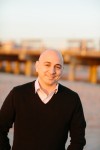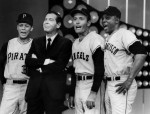For more cartoons, visit thedailysnooze.com.
Images
Tikkun olam a family affair
ORT South Africa Cape chief operating officer Debbie Staniland, right, with Harris Lorie, former education development manager of World ORT and programming co-chair of Limmud UK 2013, and Dr. Lydia Abel, ORT SA Cape director, at Limmud UK in 2013, where they were among the presenters. (photo from ORT SA Cape)
While there are innumerable reasons why people choose to volunteer, children often are inspired by the actions of their parents. Therefore, it is not surprising when two sisters who live on opposite sides of the world are both engaged in tikkun olam, repairing the world.
Linda Steiner is a longtime resident of Richmond and a stalwart at Congregation Beth Tikvah, notably for her leadership role in Isha l’Isha. Formerly known as the Women’s League, Isha l’Isha is a grassroots shul-based organization that promotes friendship and sisterhood through a wide array of programming, including self-improvement activities like Zumba and self-defence. The group also supports the synagogue’s youth program and hosts Shabbat programs that encourage women to find their place on the bimah.
Supported in part by Beth Tikvah’s gift shop, another aspect of the group’s mandate is tikkun olam. The 80 women currently involved contribute to organizations like Covenant House, Dress for Success and Chrysalis, all local charities that help those less fortunate in Greater Vancouver. And, they host speakers, the next of which will be Steiner’s sister, Debbie Staniland, from ORT SA Cape, the branch of ORT servicing South Africa’s Western Cape. On Sept. 15 at Beth Tikvah, Staniland’s topic will be LEGO Robotics for Under-privileged Youth in South Africa: Getting Children Off the Streets and into Enriching Environments.
Staniland explained in a Skype interview with the Jewish Independent that ORT in South Africa and, specifically, ORT SA Cape functions differently from ORT in most of the world. She said that, before the general elections of 1994, which saw the African
National Congress elected with Nelson Mandela at the helm, ORT South Africa was primarily a fundraising organization feeding funds to ORT programs internationally – it had little to do on the local front. In 1994, however, it gained new status as a nonprofit organization and was able to focus on educational programs for students and teachers in South Africa, as a way to build the country one child at a time.
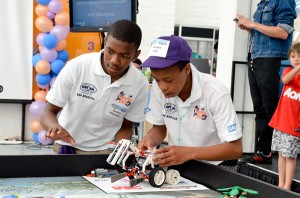
Staniland is ORT SA Cape’s chief operating officer. When in Vancouver, she will describe the great strides ORT has made in reaching children through after-school education programs, as well as in teacher training. According to Staniland, as ORT helps educate teachers and children in the Western Cape, they are planting the seeds for lasting social and economic improvement. Having worked for ORT first as a volunteer for five years and then as a professional for the past four, Staniland is very familiar with the successes and challenges of the organization.
Her talk will focus on the specialized LEGO robotics programs that ORT SA Cape uses in its after-school education program, which is designed to provide hands-on enrichment in technology, mathematics and literacy. ORT SA Cape director Dr. Lydia Abel said of the program, “The kids are instantly enthralled by the LEGO robotics and they soon discover that the only way they can build them is by reading the how-to program and, suddenly, it’s all they want to do.”
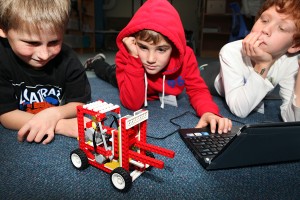
Staniland hopes to reach a wide audience when she speaks at Beth Tikvah. She is aware of the significant immigration of South Africans to the Lower Mainland in the late 1980s and 1990s, her sister being one of those immigrants. Staniland hopes that many “ex-South Africans” will be interested in reconnecting and finding out how those who stayed in the country are helping to build a better South Africa. “It’s a way to help those who have immigrated to connect,” said Staniland. “They understand many of the challenges we face and it will be nice for them to know what we are doing.”
Staniland’s lecture on Sept. 15 will start at 7 p.m. Admission is $10 (refreshments will be served) and an RSVP is requested by Sept. 9 to the synagogue office, 604-271-6262 or [email protected].
Michelle Dodek is a freelance writer living in Vancouver.
Federation’s new CEO
Ezra S. Shanken has been busy since arriving in Vancouver. (photo from Ezra S. Shanken)
“I said at our AGM that I want a Federation today that is with you in your brightest and darkest times, not because of what you give but because of who you are, and I intend to spend my years here using that statement as a driver of my performance.”
A praiseworthy benchmark for Ezra S. Shanken, Jewish Federation of Greater Vancouver’s new chief executive officer. Since he began in June, he has been busy, attending the launch of JHub in Richmond, participating in Federation’s June 16 annual general meeting, attending several community events, appearing on the radio show JFSA Voice, helping organize the community response to the Israel-Hamas conflict, joining volunteers at the Surrey Fusion Festival’s first-ever Israel pavilion, visiting various local community institutions, traveling to Israel, the list goes on.
Born in New York City, Shanken grew up in Teaneck, N.J. He is the third generation of Shankens to be involved in Jewish communal service. “For me, this is a family business of sorts,” he told the Independent, adding, “… that is something I take great pride in.”
His father was cultural arts director at the Jewish community centre when Shanken was in nursery school, before becoming an inner city high school teacher. Shanken’s grandfather flew 55 missions over Europe in the Second World War as a bombardier and then became a rabbi; he also participated in the Freedom Rides, which successfully challenged segregation in interstate bus terminals in the American South. “He is a true inspiration and I keep a picture of him and his bomber crew on my wall in my office,” said Shanken.
While Shanken has become a community professional, he admitted in an interview with ejewishphilanthropy.com that his career in this field was unexpected. About his move to Colorado after college, he told the online publisher, “The idea was to go for a year to escape from NYC, but that one year turned into eight years and into the building block to who I’ve become as a Jewish communal professional.”
Needing a job, he applied to the Allied Jewish Federation of Colorado. He credits Susan Kramer, now JEWISHcolorado chief development officer, with seeing something in him. “I went from somebody seeing something in me to me seeing something in myself to having an opportunity to see something in other people and help them along,” he told ejewishphilanthropy.com.
Shanken was at JEWISHcolorado for six years, working there in different capacities, ultimately becoming senior manager of the young adult department and major gifts. He also co-founded E-3 Event in Colorado, an organization focused on arts-based events for younger Jews (20s through early 40s). Shanken comes to Vancouver from New York, however, where he directed Emerging Leaders and Philanthropists at UJA-Federation of New York from mid-2011.
Growing up through the public school system – but attending Jewish summer camp (Ramah in the Berkshires) – Shanken did his undergraduate degree in political economics at the University of Hartford, where he was president of Hillel, and his graduate work in nonprofit management at Regis University.
“As a kid, I wanted to be a garbage man, fireman, fighter pilot but by high school I had the experience of going to Washington, D.C., and volunteering during the Clintons’ second inauguration, and that got me on to the idea of being involved in public service,” Shanken told the Independent.
Internships in his “junior and senior years of high school for a local Jewish congressman … connected to internships and experiences far out into the future,” he added.
Now, at 34, he is one of the youngest CEOs in the Federation system. And his approach has reflected that, with Shanken having been an avid user of social media throughout his career.
“I have been a big believer in social media as an outreach tool in Jewish communal work,” he said. “There is no question in my mind that if we want to engage the next generation of Jews, we are going to have to engage in the social media space. I am active on Twitter under the handle @eshanken, Facebook and Instagram. I love to share what I and we are doing every day with my followers and friends because what we do and where I get to be is truly special.”
While encouraging people to follow him on any of these media, he noted that the internet has limitations with respect to its ability to bring people and ideas together.
“To this date, I never turn down an offer to have coffee, and judge the success of my week by how many people I get together with.”
“It is my opinion that, to date, there is not a platform that replaces two chairs, a table and cups of whatever you choose,” he said. “My goal in using online platforms is to move the relationship offline. When I was developing the young leadership department at the Colorado Federation, I found the best thing we did was have hundreds of coffees where we asked young professionals, ‘Under what circumstances could you see yourself getting more involved in the organized Jewish community?’ To this date, I never turn down an offer to have coffee, and judge the success of my week by how many people I get together with.”
Informal and formal discussions will determine Federation’s – and the community’s – future trajectory.
Said Shanken, “We will be entering into a strategic visioning process with the goal of having these types of conversations. The ultimate goal is to move from strength to excellence in each of our fields of practice. For me, personally, I am more interested in the processes over the product. Creating long-lasting change in Jewish communal life is like speeding up the rotation of the earth a little at a time so people don’t fall down.”
About relocating to the other side of the continent? “Rachel and I feel truly blessed to be here in Vancouver,” said Shanken of his and his wife’s move here. “We have been blown away by the beauty of the scenery and the warmth of the community. The biggest challenge for us was figuring out how to sort our garbage at the house but once we figured that out we saw such value in it. Work-wise, my summer has been dominated, like many in our community, by the crisis [in Israel-Gaza]. However, through the crisis, I have seen the community come together in beautiful ways to show their support for Israel and each other during this difficult time.
“This community has one very special thing going for it because of the hard work of those who are around me and came before me,” he said. “We have rabbis who have built relationships across the streams of Judaism and agencies that, on the whole, get along with each other. I take it as a personal mission to keep those relationships strong because with relationships like we have, the sky is the limit to what we can accomplish.”
Food always needed: Project Isaiah
(photo from Jewish Food Bank Report 2013-14)
Project Isaiah is the annual High Holy Day food drive that assists those members of the community who are in need. All donations go directly to the Jewish Food Bank to assist individuals in the community – seniors, families and newcomers.
Sponsored by Jewish Family Service Agency and Jewish Women International-British Columbia, Project Isaiah is inspired by Isaiah 58:7: “… share your bread with the hungry.”
The Jewish Food Bank’s 2013-14 report, released last week, notes that the situation of the Jewish community mirrors that of the larger community, wherein most people living on fixed incomes or earning minimum wage in British Columbia spend 60 percent of their income or higher on housing, leaving 40 percent or less to cover utilities, medication and clothing, as well as food. With the rapidly growing cost of living, and lower economy, more families are having to access food banks for help:
• 12 percent of B.C. residents are unable to meet basic needs and do not have access to adequately nutritious food in sufficient amounts.
• For the past eight years, British Columbia has been ranked as the highest province in Canada for children living in poverty.
• Food bank usage is at an all-time high.
• 7.7 percent of B.C. residents are considered “food insecure” and go without or on reduced food intake.
The Jewish Food Bank supports almost 400 Jewish individuals. Each time clients visit the food bank, they receive approximately two to three days’ worth of food per individual.
All of the households served live at or below the poverty line and 80 percent of all households spend at least 60 percent of their income on rent. All clients are assessed and authorized by a JFSA caseworker. Currently, the food bank helps 55 children and teenagers, 248 adults and 91 senior adults.
Annually, more than 45 volunteers provide operational support to the food bank. The volunteers do the ordering, pick up donated goods, set up, as well as deliver to more than 50 homebound clients. With additional volunteers for its annual food drives, Project Isaiah, and the newly established Project Sustenance in the spring, volunteers contribute close to 3,500 hours of support.
The food bank is fully funded through the generosity of JFSA donors, the fundraising efforts and donors of JWI-BC, gift-in-kind donations of food through various food drive events, such as Project Isaiah and Project Sustenance, and ongoing donations collected by community partners. This past year, it had an operating budget of $149,200, with in-kind donations of food making up a value of $30,000 of the annual budget.
Close to 40 community partners provide ongoing food donations, supplies and space to support the Jewish Food Bank. These partners help lower the cost of operations and play a critical role.
This year’s Project Isaiah is underway, and the food bank is hoping that you will consider sharing your bread with the hungry (now and throughout the year). Take a bag home from a local synagogue or Jewish day school and return it, filled with food. A suggested shopping list includes high-nutrition items such as canned fish (tuna/salmon/sardines), peanut butter (plastic bottles only), canned fruit, canned vegetables, cooking oil (plastic bottles only), whole grain pasta/rice/cereals, legumes (canned or dried), dried fruit (prunes/apricots) and toiletries (includes children’s diapers). Note: check the “best before date” on products, as expired products cannot be accepted.
If you are unable to contribute food, JFSA and JWI-BC gratefully accept monetary donations (and issue a tax receipt).
For more information about Project Isaiah, contact Debbie Rootman at JFSA (604-257-5151, ext. 230) or [email protected], or Sara Ciacci at JWI-BC (604-838-5567).
Garay’s 20 years, with 20 dancers, 20 places
Left to right, Michelle Lui, Bevin Poole and Vanessa Goodman. (photo by David Cooper)
Dancers Dancing and SFU Woodward’s present the world première of 20.20.20, in which audiences will not just see, but feel the city come to life onstage. At the Goldcorp Centre for the Arts Sept. 24-27, the show captures the atmosphere of urban Vancouver in all of its complexities from a unique lens.
Celebrating 20 years of working in Vancouver, choreographer Judith Garay looks at 20 intersections in the city to set 20 dancers in motion – inspired by interactions of architecture, pigeons, overpasses, green spaces, mountain views, skateboards and especially the people, old and young. Contrast and contradiction drive the work to be physically exhilarating and thoughtful, prosaic and emotionally charged.
The artists – including Jewish community member Vanessa Goodman – have dug their heels into the world of Vancouver, and brought their experiences and observations back to the studio, where it has been a process of using pedestrian research and full-body articulation to create beauty in otherwise overlooked aspects of city life. The synergy of their work is expressed organically in the process, as the dancers have felt charged by the city itself. They expect a similar visceral reaction for audiences.
As the team continues to organically replicate the city life to stage, they have been surprised in how the process is revealing Vancouver. Contrasts keep resurfacing, like urban and green, rich and poor, young and old and the infamous weather that changes a sky of grey clouds to one of blinding sun. These balances reflect the ever-evolving city from day to day, and naturally beg for a creative portrayal that is full of movement and life.
With music by Stefan Smulovitz, lighting by John Carter and costumes by Margaret Jenkins, 20.20.20 steers away from a traditional tour of Vancouver, instead providing multiple ways to emotionally experience the city. Performances at the Goldcorp Centre, 149 West Hastings St., are at 8 p.m. Tickets are available online at sfuwoodwards.ca or dancersdancing.com.
Milton Berle inspired today’s comedians
Maury Wills, Milton Berle, Jimmy Piersall and Willie Mays in a salute to baseball on the television program The Hollywood Palace in 1967. (photo from ABC Television via Wikimedia Commons)
Today’s comedy superstars, especially those whose careers are driven by television, may very well owe their success to pioneering Jewish entertainer Milton Berle.
Born Mendel Berlinger in Manhattan in 1908, Berle became America’s first small-screen star. Aptly nicknamed “Mr. Television,” he influenced and helped promote the work of hundreds of younger comics.
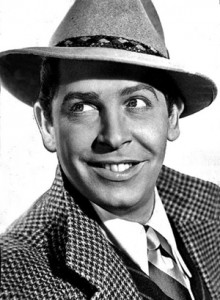
“Milton Berle was deceptively successful and very Jewish,” said Lawrence Epstein, author of The Haunted Smile: The Story of Jewish Comedians in America, published in 2002, the year Berle died. “His success came about because early television sets were mostly sold in wealthier urban areas, with Jews and gentile urbanites accustomed to and appreciative of Jewish humor. So, Berle’s quick talking, his high-speed jokes, his dressing in outlandish costumes and his sprinkling of Yiddishisms all played well. Ironically, it was Berle’s success with those urban audiences that propelled the sales of televisions around the nation.”
Epstein explained that once televisions reached the rural areas of America, viewers “took a look at [Berle] and said he spoke so fast they couldn’t understand him, and that he wasn’t funny, and [they asked], ‘What was that foreign language?’”
He said, “That is why Berle’s television career was meteoric. It burned brightly but briefly.”
Berle’s close friend Lou Zigman, a Los Angeles-based labor lawyer and Brooklyn native, disagrees with Epstein’s use of the word “meteoric,” arguing that Berle never burned out like a meteor does. Berle kept performing, assisting other comics, giving to charities and spreading Jewish culture until his death, and he was even performing card tricks as a hospital patient at age 90, according to Zigman.
“I asked Milton how come all the gentiles knew Yiddish humor,” Zigman said in an interview. “He answered that the great majority of comedians and writers in those early years were Jewish. That’s why it spread, and our culture spread, all over the country.”
At age 5, Berle won an amateur talent contest and appeared as a child actor in silent films. He became a vaudevillian at age 12 in a revival of the musical comedy Florodora in Atlantic City, N.J., and was hired by producer Jack White in 1933 to star in Poppin’ the Cork, a musical comedy concerning the repealing of Prohibition. From 1934-36, Berle was heard frequently on The Rudy Vallee Hour radio show and attracted publicity as a regular on The Gillette Original Community Sing, a Sunday night comedy-variety radio program broadcast on CBS. Then came the Milton Berle Show, a variety format he would revive for his television debut.
Read more at jns.org.
Discovery of copper awl at Tel Tsaf a game changer
A copper awl from the fifth millennium BCE that was discovered at the site in Tel Tsaf. (photo by Yosef Garfinkel via Ashernet)
Excavations at Tel Tsaf in the Jordan Valley, near the Jordan River, revealed in a woman’s grave a small copper awl. Generally speaking, this would not have been regarded as special except, in this instance, the grave where the awl was found dates from 5200 BCE.
This find, announced by archeologists from the Zinman Institute of Archeology of Haifa University on Aug. 24, pushes back the time that metal technology was thought to have been introduced into the region by at least 500 years. The awl is probably the oldest metal object ever found in the Middle East.
The find also adds another dimension to the Tel Tsaf community itself. Discovered in 1950, it was not until about 10 years ago that it was established from excavations directed by Prof. Yosef Garfinkle that Tel Tsaf dated to about 5200 to 4700 BCE, the Middle Chalcolithic period.
It was clear that Tel Tsaf was a centre of regional commerce. There were silos that could store up to 30 tons of grain in each individual silo, and excavations, including burial sites, had revealed painted pottery, bullae (seals), basalt and obsidian beads, seashells, but no copper – until now.
The discovery of the copper awl would point to a population with advanced technology, and the fact that a copper implement was discovered at the site has a significant bearing on understanding the history of the period, both in Tel Tsaf and the rest of the Middle East.
DNA’s not only factor
Epigenetics: environmental effects influence how genes are turned on or off. (photo by Yuval Robichek via wis-wander.weizmann.ac.il)
Blood stem cells have the potential to turn into any type of blood cell, whether it be the oxygen-carrying red blood cells or the many types of white blood cells of the immune system that help fight infection. How exactly is the fate of these stem cells regulated? Preliminary findings from research conducted by scientists from the Weizmann Institute and the Hebrew University are starting to reshape the conventional understanding of the way blood stem-cell fate decisions are controlled, thanks to a new technique for epigenetic analysis they have developed.
Understanding epigenetic mechanisms (environmental influences other than genetics) of cell fate could lead to the deciphering of the molecular mechanisms of many diseases, including immunological disorders, anemia, leukemia, and many more. It also lends strong support to findings that environmental factors and lifestyle play a more prominent role in shaping our destiny.
The process of differentiation – in which a stem cell becomes a specialized mature blood cell – is controlled by a cascade of events in which specific genes are turned “on” and “off” in a highly regulated and accurate order. The instructions for this process are contained within the DNA itself in short, regulatory sequences. These regulatory regions are normally in a “closed” state masked by special proteins called histones to ensure against unwarranted activation. Therefore, to access and “activate” the instructions, this DNA mask needs to be “opened” by epigenetic modifications of the histones so it can be read by the necessary machinery.
In a paper published in Science, Dr. Ido Amit and David Lara-Astiaso of the Weizmann Institute’s immunology department, together with Prof. Nir Friedman and Assaf Weiner of Hebrew University, charted for the first time histone dynamics during blood development. From the new technique for epigenetic profiling they developed, in which just a handful of cells – as few as 500 – can be sampled and analyzed accurately, they have identified the exact DNA sequences, as well as the various regulatory proteins, that are involved in regulating the process of blood stem-cell fate.
Their research also yielded unexpected results: as many as 50 percent of these regulatory sequences are established and opened during intermediate stages of cell development. This means that epigenetics is active at stages in which it had been thought that cell destiny was already set. “This changes our whole understanding of the process of blood stem-cell fate decisions,” said Lara-Astiaso, “suggesting that the process is more dynamic and flexible than previously thought.”
Although this research was conducted on mouse blood stem cells, the scientists believe that the mechanism may hold true for other types of cells. “This research creates a lot of excitement in the field, as it sets the groundwork to study these regulatory elements in humans,” said Weiner. Discovering the exact regulatory DNA sequence controlling stem-cell fate, as well as understanding its mechanism, holds promise for the future development of diagnostic tools, personalized medicine, potential therapeutic and nutritional interventions, and perhaps even regenerative medicine, in which committed cells could be reprogrammed to their full stem-cell potential.
For more Weizmann Institute news releases, visit wis-wander.weizmann.ac.il.
– Courtesy of Weizmann Institute
Taking pianos to the streets
Sean Pacey dabbles at the keys in Burnaby, near the Shadbolt Centre for the Arts. (photo from Sean Pacey)
Keeping a business afloat for more than four decades is accomplishment enough, but to keep it in the family is especially noteworthy. “My grandfather and his oldest son started the shop in the 1970s,” said Sean Pacey, the current owner of Pacey’s Pianos on Broadway. “In the 1980s, my father took over. When I was 18, my father gave me the keys and walked away.”
The young Pacey was well qualified for the job. “My mom has a small manufacturing business, and I helped her since I was 11,” he recalled. “I’d come home from school and answer the phones. At 13, I started working at tradeshows, representing her company all over the world. We traveled to Germany, China, Taiwan, Japan, Korea, Hong Kong and many cities in North America.”
Later, already the owner of the piano shop, Pacey got his diploma in business and marketing from the University of British Columbia.
It’s been a little over a dozen years since he accepted the keys to Pacey’s Pianos. In that time, he has expanded the company, and it offers more services and events than it did in his grandfather’s and father’s days, including charitable enterprises. One of these charities is Support Piano, the Vancouver version of Street Piano.
The Street Piano movement started in 2008 in England and has spread worldwide. More than a thousand pianos have been installed outdoors in 45 cities across the globe. Anyone who wants can play them. Some impromptu players are professional musicians, others are children learning to play or adults who learned in the past but, for various reasons, abandoned their music. The freely available pianos entice many hidden musicians out of the woodwork.
Vancouver picked up the initiative last year, when City Studio installed three instruments in public spaces during the summer. This year, the number has increased manifold: City Studio installed 10 pianos, and Pacey partnered with the studio, donating 12 more pianos for the project. However, he wasn’t satisfied with simply leaving a piano on a street corner. He wanted communities to unite around the instruments, to claim ownership of their urban landscape and its music.
“We engaged in similar projects since 2009 but not on such a scale,” he said. “For this project, we decided to match each piano we installed with a certain group we wanted to showcase. Every opening was a musical event. The involved group painted the piano, and there was a concert by a professional musician.… For me, it is a strictly nonprofit venture; it is about doing something beautiful.”
Pacey’s sponsorship groups came from all over Metro Vancouver and included neighborhood kids from a summer camp, seniors with mental disabilities and terminally ill children. “We picked iconic locations that meant something to us,” he explained. “I had a dream to have my instruments everywhere – in a public park, on a lake shore, on a mountain, under the Skytrain, at a music festival.”
He made his dream come true. The pianos with his shop’s mark are standing on Grouse Mountain and under the Skytrain station in Surrey. They offer their black and white keys to anyone who wants to play in Richmond and East Vancouver, Burnaby and Squamish. One of his pianos allows pianists to entertain visitors beside the Jewish Community Centre of Greater Vancouver.
“I drive through the spots of our pianos and, everywhere, people are playing. It’s amazing,” he said.
To inspire more participants, Pacey organized a video competition. “People play our pianos, film themselves and upload their videos on our website. We’re going to select a winner and award him or her $400 plus an opportunity to play with the Lions Gate Sinfonia.”
For Pacey, the project is a collaboration between the city, the people and the music world, and his pianos are conduits of connection. He drew performers for the opening and closing ceremonies for each instrument from the wide pool of professional piano players. Some of them are his personal friends, others he met through his shop or his several musical charities.
Philanthropy plays an important role in Pacey’s life. He wants to give to the community, so he contributes much to various nonprofits – and not just money or his pianos but his time and energy, too. He sits on the boards of several local organizations, including Lions Gate Sinfonia Orchestra.
His “baby” charity is the Piano Teachers Federation, which he founded in 2009. “I wanted to make it easier for piano teachers and students to find each other, to find the right fit,” he explained.
The database of the federation is extensive and covers many areas of the city. He personally interviewed every teacher member before adding him or her to the database. Some of them played during the opening ceremonies of Support Pianos, and other members will play at the closings.
“Our Facebook page for Support Pianos already has over 1,500 likes,” he said. “And it’s only been since the beginning of July.”
The pianos are going to grace their public locations until the end of September. “We’ll have a closing ceremony for each one,” he said, “before we collect them. If any of the instruments are in good condition, we might reuse them next summer.”
To learn more – and to upload a video submission – check out supportpiano.com.
Olga Livshin is a Vancouver freelance writer. She can be reached at [email protected].
This week’s cartoon … Sept. 5/14
For more cartoons, visit thedailysnooze.com.



